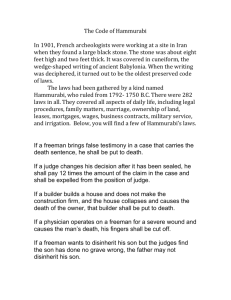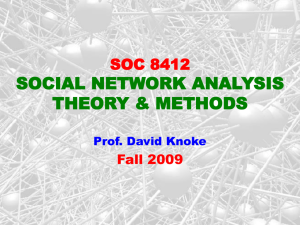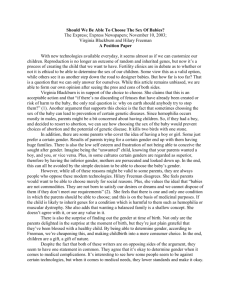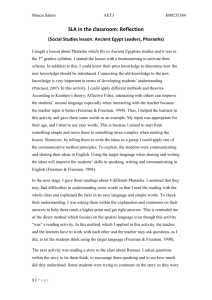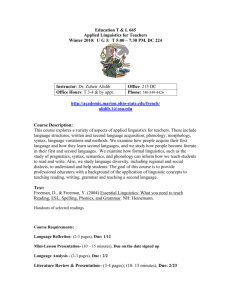COURSE SYLLABUS: CI 161 METHODS AND MATERIALS OF FOREIGN LANGUAGES
advertisement
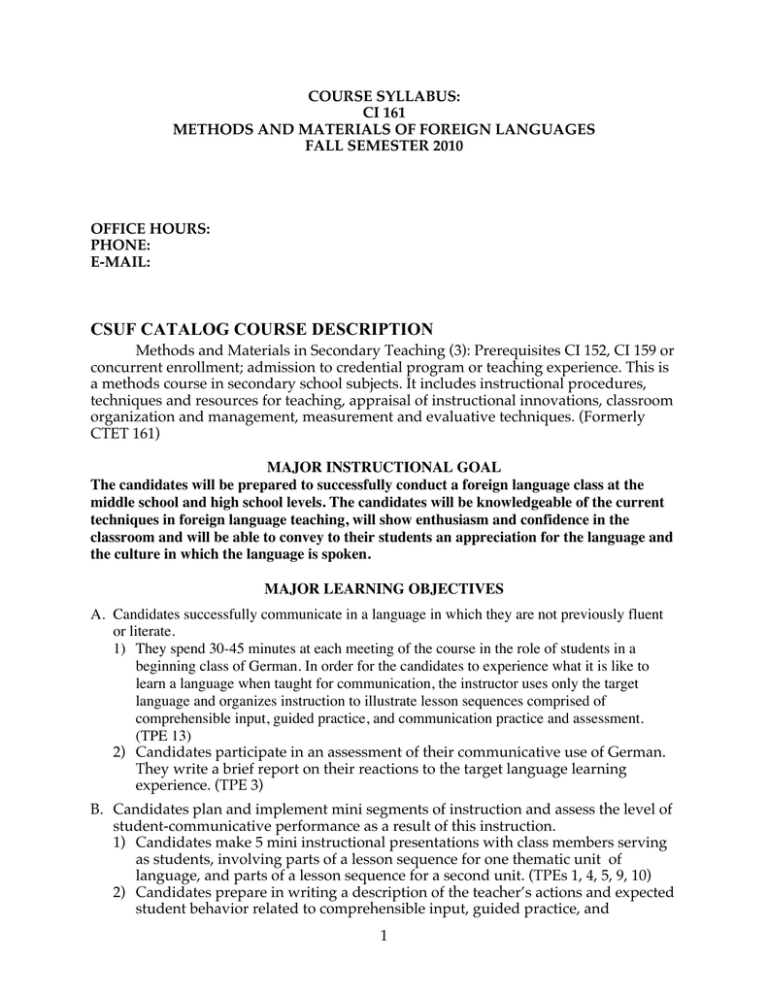
COURSE SYLLABUS: CI 161 METHODS AND MATERIALS OF FOREIGN LANGUAGES FALL SEMESTER 2010 OFFICE HOURS: PHONE: E-MAIL: CSUF CATALOG COURSE DESCRIPTION Methods and Materials in Secondary Teaching (3): Prerequisites CI 152, CI 159 or concurrent enrollment; admission to credential program or teaching experience. This is a methods course in secondary school subjects. It includes instructional procedures, techniques and resources for teaching, appraisal of instructional innovations, classroom organization and management, measurement and evaluative techniques. (Formerly CTET 161) MAJOR INSTRUCTIONAL GOAL The candidates will be prepared to successfully conduct a foreign language class at the middle school and high school levels. The candidates will be knowledgeable of the current techniques in foreign language teaching, will show enthusiasm and confidence in the classroom and will be able to convey to their students an appreciation for the language and the culture in which the language is spoken. MAJOR LEARNING OBJECTIVES A. Candidates successfully communicate in a language in which they are not previously fluent or literate. 1) They spend 30-45 minutes at each meeting of the course in the role of students in a beginning class of German. In order for the candidates to experience what it is like to learn a language when taught for communication, the instructor uses only the target language and organizes instruction to illustrate lesson sequences comprised of comprehensible input, guided practice, and communication practice and assessment. (TPE 13) 2) Candidates participate in an assessment of their communicative use of German. They write a brief report on their reactions to the target language learning experience. (TPE 3) B. Candidates plan and implement mini segments of instruction and assess the level of student-communicative performance as a result of this instruction. 1) Candidates make 5 mini instructional presentations with class members serving as students, involving parts of a lesson sequence for one thematic unit of language, and parts of a lesson sequence for a second unit. (TPEs 1, 4, 5, 9, 10) 2) Candidates prepare in writing a description of the teacher’s actions and expected student behavior related to comprehensible input, guided practice, and 1 communication practice and assessment in each of the two lesson sequences. (TPEs 1, 2, 3, 4, 5, 9, 10, 11) 3) Candidates use only the target language as the medium of instruction in each of the mini presentations. (TPE 1) 4) Candidates implement four steps in giving directions for each of the mini presentations: a. give simple directions in the target language; b. model the activity with teacher and one or more students; c. have only students model the activity; d. repeat the directions in the target language. (TPEs 4, 5, 6, 7) C. Candidates demonstrate that they can 1) describe a variety of activities which may be used to accomplish comprehensible input, guided practice, and communication practice and assessment. (TPEs 3, 4, 5, 6, 7, 9, 10) 2) name and describe the nature of major resources which may be used to support instruction in a FL classroom, such as the state framework and the national FL standards. (TPEs 1, 12, 13) 3) describe a variety of strategies for effectively managing activities in the FL classroom. (TPEs 2, 4, 5, 6, 7, 8, 10, 11) 4) name and briefly describe currently available text materials in the language they want to teach. (TPEs 1, 12, 13) 5) describe how instructional strategies may be modified to teach the same thematic unit of language to students at various levels of language control, within a single class or for students at various levels of study (beginners, intermediate). (TPEs 2, 4, 6, 7, 8) 6) help students to understand the structural regularities and irregularities in language which they already can use for communication. (TPEs 1, 4, 5) 7) write an assignment, aligned to the national content standards, accompanied by an assignment-specific rubric. (TPEs 1, 3) 8) describe the critical inquiry process. (TPEs 3, 12, 13) 9) write a personal reflection of their own work. (TPEs 12, 13) 10) recognize and utilize instructional media and technology. (TPEs 11, 12, 13) 11) display enthusiasm for teaching and learning foreign languages. (TPEs 1, 8, 11, 12) believe that every student can learn, when there is the proper support for them. (TPE 6, 7, 8) REQUIRED TEXTS The Freeman Manual, compiled by Dr. R. Freeman, 2000, Adapted by J. Cardella 2008 Teacher’s Handbook, 3rd Edition Revised, Shrum and Glisan, Heinle and Heinle, 2005 Foreign Language Framework for California Public Schools, Calif. Dept. of Educ., 2003 Foreign Language Content Standards for California Public Schools K-12, 2008 2 RECOMMENDED TEXTS Teaching Language in Context, 3rd Edition, Omaggio-Hadley, Heinle and Heinle, 2001 Developing Second Language Skills, Chastain, 1976 WEBSITES Blackboard - http://blackboard.csufresno.edu Heinle & Heinle - http://www.heinle.com Framework - http://www.cde.ca.gov/ci/fl/cf/index.asp FLTEACH – http://www.cortland.edu/flteach/ Teacher Web – http://www.teacherweb.com PROFESSIONAL DEVELOPMENT Central Valley Foreign Language Association (CVFLA) (October 18, 2008 Conference at FCC) California Language Teachers Association (CLTA) www.clta.net, (February 26-March 1, 2009 Conference in Sacramento, CA) California Foreign Language Projects CFLP (Summer Seminars in Santa Barbara) JOURNALS (In Periodical Section – Current issue available. Past issues are ordered online.) Foreign Language Annals (ACTFL) www.actfl.org, French Review (AATF) www.frenchteachers.org, Hispania (AATSP) www.aatsp.org, German Quarterly (AATG) www.aatg.org, Modern Language Journal (MLA) http://www.mla.org, Studies in Second Language Acquisition, TESOL Quarterly, Language Learning, www.tesol.org CHANGES IN THE SYLLABUS This syllabus is tentative. The students will be notified in advance of any changes. STUDENTS WITH SPECIAL LEARNING NEEDS Students with special needs should speak to the professor privately. CHEATING/PLAGIARISM Students are reminded that CSUF has a written policy on cheating and plagiarism. Please be aware that your work should be strictly your own: don’t copy someone else’s work whether it be from a colleague, from a published author, or from the Internet. CLASSROOM EMERGENCY PREPAREDNESS The person responsible for the Department of Foreign Languages & Literatures is Laura Gribben. Her office is in Engineering East 220. Her phone is 559-278-5249. In the event of an emergency, you should proceed to the nearest exit in an orderly manner. Once outside the building, you many not reenter it until the building has been declared safe. 3 ASSESSMENT OF LEARNING OBJECTIVES The student’s final grade for this course will be based on the following: 1. Quizzes (15%) The quizzes will be worth 25 points each. They will ask questions based on the previous week’s discussions in addition to the assigned readings. They may be given anytime during the class session. 2. Written Homework (15%) The homework will be worth 15 points each. It may include exercises from the book, lesson plans, portfolio artifacts, reflections on readings, creating rubrics, presentations, abstracts, etc. The homework is always due the week after it is assigned. Be sure to check your work for spelling and grammatical errors. 3. Class Participation (20%) Class participation includes being in class on time, taking part in class discussions, and showing enthusiasm for the activities done in class. Each class is worth 15 points. 4. Presentations (35%) You will be asked to give 4 mini-presentations. Each mini-presentation will be worth 50 points. Each of these presentations will represent some segment of the teaching sequence (input, practice, application). In addition you will give one final presentation. It will be worth 150 points. This presentation will include a comprehensible input and a guided practice activity. The candidate will then explain the communicative activity that will follow these other activities. 5. Written Final (15%) The written final is worth 150 points. It will include everything discussed throughout the semester. Check the list of possible questions in The Freeman Manual. GRADE VALUES GRADE A B C D HW/CLASS P. 14-15 12-13 10-11 8-9 QUIZZES MINIPRESENT. 45-50 40-44 35-39 27-34 23-25 20-22 17-19 14-16 4 FINALS 135-150 120-134 105-119 82-104 TOTAL POINTS 900-1000 800-899 700-799 550-699 TENTATIVE COURSE OUTLINE DATE 1st class Aug. 27 COURSE CONTENT PRACTICE German class (music, introductions, greetings, Theme 1 input, numbers, lotto, four corners, song, Fra Martino) Overview of course THEORY What is communication? Grammar translation vs. Communication First day procedures Typical foreign language class DISCUSSION Ice breaker: Why study languages? Beginning: Organizing year. Organizing files. Websites: http://blackboard.csufresno.edu www.clta. net http://eleaston.com www.teacherweb.com ASSIGNMENT 1) Read Freeman Manual, pp. 4-14 2) http://tlc.heinle.com Click on Online Workbook for Chapter 1. Complete 1.1 and e-mail to me at j.torrance@comcast.net 3) Go to http://eleaston.com Look under Language Classroom and then click on Teaching Methods. Read any article for discussion next time “What to do the 1st Day?” 2nd class Sept. 3 PRACTICE German (Theme 1, guided practice, 5-a-day, true/false, review, lotto, flyswatters, Theme 2, input, alphabet eye chart, colors, conversations, signatures, Theme 1, Application cards Go fish, song Santa Lucia) THEORY Quiz History of teaching languages Jigsaw Standards (themes/functions) Grammar/translation vs. Communication DISCUSSION Readings from websites Focus activities: Before the bell 1) Read Freeman Manual, pp. 15-20 2) Read Teacher’s Handbook, Chaps. Preliminary, 1& 2 3) Prepare p. 32. Episode Two, #1-10 and p. 58 Episode Two, #1 & 2 3rd class Sept. 10 PRACTICE German (Theme 2, guided practice, 5 a day, write alphabet, numbers, colors, Theme 3, input, video of house) THEORY Quiz Debrief comprehensible input (Into) More examples: Manipulatives, transparencies Lesson sequence Recursive curriculum design DISCUSSION Integration of instruction Readings. Episode Two Review of History of FL Teaching Songs Selecting and evaluating a textbook Freeman Manual, Ideas Section, pp. 126-140 5 1) Read Freeman Manual, pp. 21-38 2) Read Teacher’s Handbook, Chapter 3 3) Prepare p. 87, Task A 4) Recommended reading on Electronic Reserve: Password: forlang Teaching Language in Context, pp. 105-129 5) Recommended reading on Electronic Reserve: Password: forlang Chastain, Developing Second Language Skills, Chap. 2 4th class – Sept. 17 5th class – Sept. 24 PRACTICE German (Theme 3, guided practice, 5 a day, What is in room?, recognition activities flyswatters with vocabulary, cut vocab., bingo, word association, put furniture in room, concentration) THEORY Quiz Debrief Guided practice (Through) Modeling DISCUSSION Recognition to Recall/ Mechanical to Meaningful Meaningful/Communicative Review: History of FL Teaching Lesson Planning Freeman Manual, Ideas Section, pp. 141-157 PRACTICE Presentations (Inputs) (5 minutes) German (Cohort 3, guided practice, 5 a day, recall activities, In what room?, dice, A/B pictures, paired pictures, categories,, cloze exercise) 1)Read Freeman Manual, pp. 33-52, pp. 76-77, pp. 84-88 2) Review Teacher’s Handbook, pp. 86-87 3) Prepare a 5 min input for presentation - with cognates, gestures, visuals, and comprehension checks, i.e. yes/no questions, either/or questions, point to. . . 1) Read Freeman Manual, pp. 53-69 2) Read Teacher’s Handbook, Chaps. 4 &5 3) Recommended reading: Teaching Language in Context, Chap 6 THEORY Recall and production-type activities DISCUSSION Oral proficiency 6th class – Oct. 1 7th class – Oct. 8 PRACTICE German (Themes 2 & 3, Application, conversation carousel, student does TPR with partner to put furniture in room, draw house, label, share with partner, song Volare) THEORY Quiz Debrief: Application (Beyond) Interpretive, Interpersonal, Presentational Skills Readings, stories, myths, fables Cooperative learning, Graphic organizers DISCUSSION Into, Through, Beyond w/ Three Little Pigs Graphic organizers, Found Poems Review modeling Freeman Manual, Ideas Section, pp. 158-246 PRACTICE Presentation (Follow Presentation Model for Guided Practice) (5 min) German (Theme 4, Application, student narration of video, Theme 5, Into, adjectives) THEORY Teaching structure through stories or themes 6 1) Freeman Manual, pp. 36-38, pp. 7075 2) Read Teacher’s Handbook, Chap. 6. 3) Recommended reading, Teaching Language in Context, Chap 5 4) Prepare a guided practice: Explain, model, model with students, have two students do it, explain again. 1) Read Freeman Manual, pp. 78-83, pp. 93-97 2) Read, Teacher’s Handbook, Chap. 7 3) Write out pp. 206-207, Episode 2, #6. Be prepared to present pp. 206-207, Episode 2, #3 & #6 8th class – Oct. 15 9th class Oct. 22 10th class Oct. 29 11th class Games to teach grammar DISCUSSION Is it Into, Through, or Beyond? (Freeman, p. 72) Developing presentational skills PRACTICE Presentations by class members (5 minutes each) German (Theme 5, Input - name, age, characteristics, likes, dislikes, Theme 4, practice, review all songs, race) THEORY Culture (music, songs, art, civilization, history, literature, foods, holidays) DISCUSSION Heritage Speakers, Diversity, Learning styles, Intelligences PRACTICE German (Guided Practice – name, age, characteristics, likes, dislikes, two sides, ESP, video, letter, writing activities, listing, writing questions, competition) THEORY Writing Strategies (listing, quick-writes, write-a-rounds, Novice level, Intermediate level) DISCUSSION Homework, designing assignments Jigsaw Framework (quiz) Freeman Manual, Ideas Section, pp. 247-286 PRACTICE German (5 a day, completion, Application, money memories, draw and tell, conversation cards, skit, project) THEORY Quiz Writing Process (brainstorming, planning, organizing, words that jump out, show not tell, peer editing, revising, publishing) DISCUSSION Portfolios Adapting activities in textbooks How to teach a chapter (theme, functions, structures) Freeman Manual, Ideas Section, pp. 287-299 GUEST LECTURER: C. PADILLA 7 1) Read Freeman Manual, pp. 98-102 2) Read Teacher’s Handbook, Chaps. 8 & 10 3) Go to http://www.heinle.com Read Appendix 7: You should be able to download PDF files with no password. If not, try the following: (Username: worldsite Password: scott). In one of the lessons, find an interesting Application activity. 3) Jigsaw F.L. Framework for Calif. Public Schools, which is available in Reserve Book room in library or at www.cde.ca.gov/ci/fl/cf/index.asp 4) Recommended reading on Electronic Reserve:Password: forlang, Teaching Language in Context, Chap. 8, pp. 345-385 1) Read Freeman Manual, pp. 247-286 2) Read Teacher’s Handbook, Chap. 9 3) Write out p. 304, Episode 1 4) Prepare for quiz 5) Recommended reading Teaching Language in Context, Chap. 7 1) Prepare: Portfolio artifact for presentation in German Feel free to email me a rough draft for correction. 2) Read Freeman Manual, pp. 89-92 and pp. 287-299 1) Read Freeman Manual, pp 103-111 Nov. 5 Management/Assessment/Discipline Timers, bells & whistles PRACTICE Presentation of German Portfolios THEORY Performance-based assessment, Tests, grading, correction, evaluation Rubrics and critical inquiry DISCUSSION Freeman Manual, Ideas Section, pp. 300-396 2) Read Teacher’s Handbook, Chap. 11 3) Recommended reading, Teaching Language in Context, Chap. 9 12th class Nov. 12 PRACTICE Presentations (12-15 min. each) (5 presentations) Discussion of Management 1) Prepare 15 minute presentation (11/17 & 12/1) 2) Read Freeman Manual, pp. 113-119 3) Read Teacher’s Handbook, Chap. 12 4) Prepare pp. 399-401 (312-314) Case Study I (for 11/30 & 12/7) THEORY Assessment DISCUSSION AP classes/multilevel classes/plays Evaluations 13th class Nov. 19 14th class Dec. 3 15th class Dec. 18 8:0010:00P PRACTICE Presentations (12-15 min. each) (5 presentations) THEORY Other conversation ideas Be Aware!!! DISCUSSION Extracurricular activities (clubs, trips, fairs, camps) Freeman Manual, Ideas Section, pp. 397-430 PRACTICE Presentations (12-15 min. each) (5 presentations) THEORY Standards revisited Technology: The Internet & Web-based lessons, Producing visuals DISCUSSION Classroom Control: What do I do if . . .? Getting a Job Organizations, conferences Reflection Review for final Written Final 8 1) Prepare 15 minute presentation (11/30 & 12/7) 2) Read Freeman Manual, pp. 113-119 3) Read Teacher’s Handbook, Chap. 12 4) Prepare pp. 399-401 Case Study I (for 11/30 & 12/7) 1) Read Freeman Manual, pp. 120-124 2) Prepare a reflection piece. 3) Study for final.
